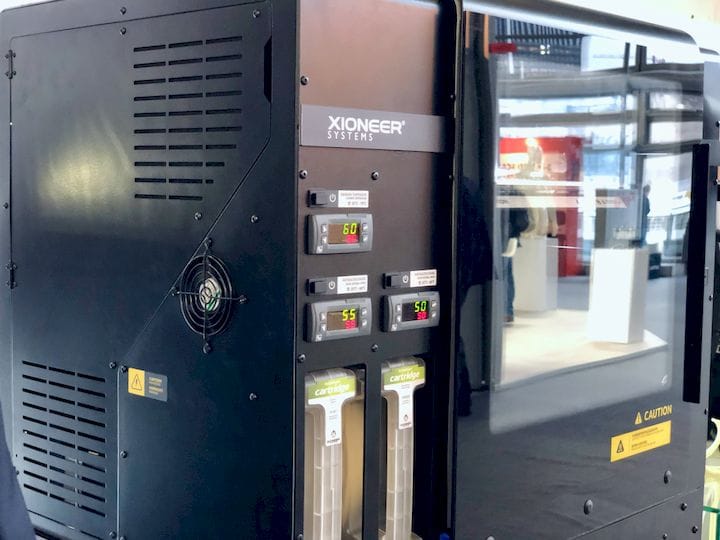![The Xioneer Industrial 3D Printer [Source: Fabbaloo]](https://fabbaloo.com/wp-content/uploads/2020/05/image-asset_img_5eb09b3eec23e.jpg)
We had a close look at the Xioneer industrial 3D printer.
Xioneer is a Vienna-based company that produces both a desktop device and the rather large 3D printer we are examining today. It’s named the Xioneer Industrial, whereas their other 3D printer is known as the Xioneer Desktop.
The Industrial is able to 3D print in a wide variety of engineering materials in a reliable and consistent manner. The available materials include PC, ASA, TPU, carbon fiber, and most frequently nylon materials. The Xioneer Industrial also supports both breakaway and water soluble support materials.
While the dual print heads on the Xioneer Industrial are typically used for water soluble support, it is also possible to perform multi-material 3D prints with the device. Here we see a dual material print made from a strong nylon and a flexible TPU:
![A multi-material print made on the Xioneer Industrial 3D printer [Source: Fabbaloo]](https://fabbaloo.com/wp-content/uploads/2020/05/xioneer-multimaterial-1_result_img_5eb09b3f57fb2.jpg)
A key feature of any industrial 3D printer must be the consistency and reliability of the prints. Xioneer has taken several steps to make this a reality on their large machine.
![All operational temperatures are carefully monitored on the Xioneer Industrial 3D printer [Source: Fabbaloo]](https://fabbaloo.com/wp-content/uploads/2020/05/image-asset_img_5eb09b3f9b4b1.jpg)
One step is to ensure an extremely consistent 3D printing environment. This includes an integrated heating and cooling subsystem that ensures the build chamber is always at a precise temperature during operations. This should minimize the thermal effects (warping) on most prints. By the way, the build chamber is quite generously sized at 295 x 275 x 305 mm.
![The Xioneer Industrial 3D printer in operation [Source: Xioneer]](https://fabbaloo.com/wp-content/uploads/2020/05/image-asset_img_5eb09b40016dc.jpg)
Another step is to perform automatic calibration before 3D printing commences. This is a feature that is found in most 3D printers these days, and is sometimes called auto leveling. However, Xioneer uses a somewhat different and possibly unique approach to calibration. While most devices simply place a distance sensor at several points along the build surface to detect the topography, Xioneer has a more sophisticated approach.
Their approach uses a patented technology to detect in considerable detail the entire topography of the build surface. Essentially, they 3D scan the surface. This allows them to execute the first layer of prints in a far more reliable manner.
Xioneer has designed their printheads to be swappable. They offer no fewer than four different types of printheads that can be easily removed and installed as required, depending on the material in use. The four types are:
-
Standard — special coating for consistent material flow and high reliability
-
Fine — specially formed nozzle tip for printing fine details
-
Bold — high material throughput for fast prints
-
Hard — abrasive-resistant ceramic nozzle for printing fiber-reinforced materials
They explain:
“Our nozzle units can be switched within minutes to adapt quickly to your actual printing needs. They are currently available in the options Standard, Fine, Hard, and Bold. The system recognizes automatically whether the current nozzle unit is suitable for the inserted material as well as for the upcoming print job. The integrated usage indicator helps to monitor its usage; thus increasing reliability through preemptive maintenance.”
One aspect of the Xioneer Industrial 3D printer might be its material strategy. This device only uses proprietary material cartridges, and thus you will not be able to use inexpensive third-party materials in the machine.
For some 3D printer operators the use of open materials is a critical aspect, so that operational costs can be lowered and vastly increased choice of materials are available. However, that is not the objective of this machine; the goal here is to achieve high-quality prints in a consistent manner. That is the essence of a production 3D printer.
![Comparison of nylon 3D prints, with the right example being exposed to moisture in the air [Source: Fabbaloo]](https://fabbaloo.com/wp-content/uploads/2020/05/xioneer-nylon-prints-1_result_img_5eb09b4045eb3.jpg)
Another benefit of the use of proprietary cartridges by Xioneer is that the material quality can also be controlled in an environmental way. Here we see two prints in nylon material, one having been securely stored in a cartridge, and the other exposed to the ambient environment and absorbing moisture that corrupts the print.
By controlling the materials used in the machine, Xioneer is able to fine-tune the relationship between machine movements, thermal plastic, and temperature to achieve near-perfect results. That’s the trade-off here: to get the best quality you must use specific materials.
![Material cartridges in use on the Xioneer Industrial 3D printer [Source: Fabbaloo]](https://fabbaloo.com/wp-content/uploads/2020/05/image-asset_img_5eb09b41262e0.jpg)
And what might those materials be? We took a look at Xioneer’s current materials shelf and found the following:
-
ModelPlus — A PLA-based general printing material
-
PET-G — The popular chemically-resistant durable material
-
PA-6X — A tough nylon material
-
PA-CF — A a mix of nylon and carbon fiber
-
PC-X — A polycarbonate mix
-
TPU98A — A flexible material
-
ABS — The commonly used general printing material
-
ASA — A very durable weather resistant material
-
PVOH — A water soluble support material
-
GeckoPeel — A unique “peelable” support material that is also flexible
In all, the Xioneer Industrial seems to be a very well-designed 3D printer suitable for production and prototyping in industrial settings.
Via Xioneer











FELIXprinters has released a new bioprinter, the FELIX BIOprinter, which is quite a change for the long-time 3D printer manufacturer.